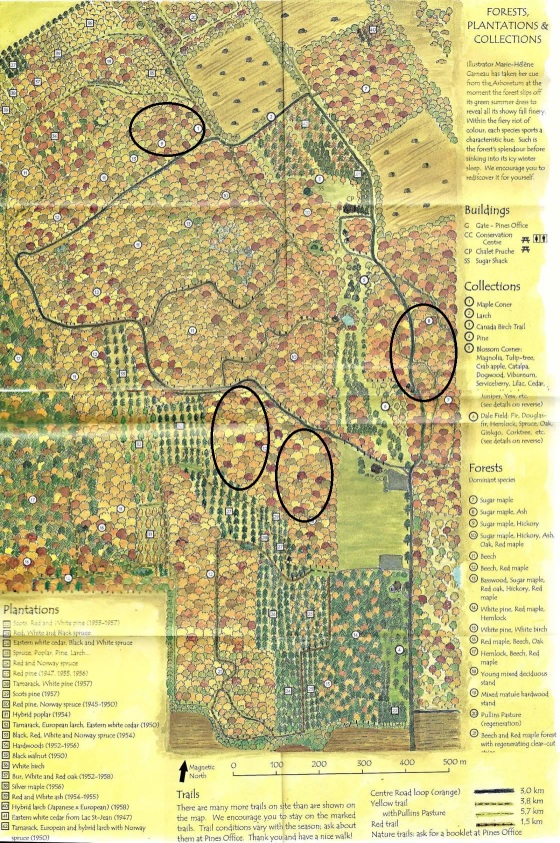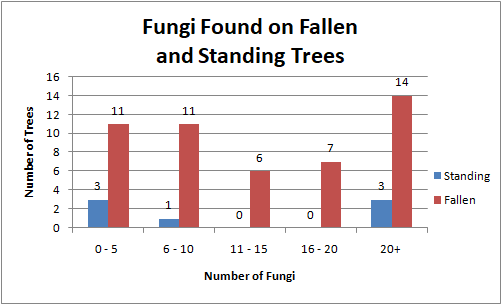The shelf fungus, or Polyporaceae, is a species with a fruiting body, containing pores or tubes which, as its common name suggests, is shaped like a round tablet. That being said, they come in many forms, colours and shapes (see figures 1 to 3). In fact, about 1700 species of these wood-rotting organisms were recorded in North America (Gilbertson, 1980).
It is important to know that shelf fungi are dead-wood dependent organisms: most of the time, they grow on dying or dead trees. Their habitat in North America may range from the Arctic tundra to southern deserts, as they can be observed on both deciduous and coniferous trees (Gilbertson, 1980). They thrive in moist and damp environments, especially in fresh and wet weather. By encouraging the decay of dead trees, tree trunks and logs, they provide habitats for numerous organisms, which explain their importance for the biodiversity and the health of forest ecosystems (Lonsdale et al., 2007). They can also be a source of food for certain species of animals, invertebrates and insects feeding on their spores.
Shelf fungi reproduce by releasing spores, which are transported by the wind and spread on dead or dying wood. The spores then infect the internal part of the tree and draw out nutrients, originating from the sun and soil, into the fruiting body of the fungus, the conk (Davis, 2015). Essentially, fungi grow by decaying their host and feeding on the organic matter contained inside the tree. Most grow during spring and fall on already decaying wood. Fungi may seem harmful to tree farming, since they infect the wood at their core, but it is important to keep in mind that they play a big part in nutrient cycling. Decaying plants are decomposed into organic matter by polypores, and is then transformed into inorganic matter to be exploited by other plants to ensure their own growth (Gilbertson, 1980). By decomposing the plants’ cellulose, shelf fungi can return 85 billion tons of carbon to the atmosphere in one year (Gilbertson, 1980).
Polypores, or shelf fungi, are an important group of wood-decaying fungi because they are able to decompose plant tissues in the cell wall of woody plants, and therefore, recycle the nutrients within an ecosystem (Zhou et al., 2016). Wood-decaying fungi also provide small habitats for other organisms to live in (Lonsdale et al., 2007), such as moss, which grows on top of polypores due to their long lifetime and their toughness (Zjawiony, 2003).
In addition, polypores are known as saprobic wood decayers because they obtain their nutrients by absorbing them from dead logs (Zjawiony, 2003). The fungi absorb the nutrients using small threads called mycelial strands or mycelium (Journal of education, 1908). These strands enter the tissues of the plant and harness the nutrients that are present (Journal of education, 1908). A log covered in fungi decomposes nearly 40% faster than one that is not covered (Mattson et al. 1987). This shows how important polypores are for recycling important nutrients from wood back into the ecosystem.
Looking at past research, it’s been concluded that the difference in the number of fungi present for common and red-listed species is dependent on the quantity of dead logs (Hottola, 2009; Simila et al. 2006). Subsequently, deforestation has been linked to reduced polypore growth. In Fennoscandia, the volume of coarse woody debris has been reduced by greater than 90% (Penttilä, 2006) due to this phenomenon. The loss of dead wood reduces the possible habitats that shelf fungi can grow on, and ultimately, is detrimental to the presence of shelf fungi. In Sweden and Finland, for example, there was evidence of loss of fungi in forest stands that had been clear-cut and had had their wood debris removed (Amaranthus et al. 1994). Insight into this matter can indicate what forest areas should be conserved (Simila et al. 2006).
Forest stands rich in polypores are typically considered healthy and fertile (Amaranthus et al. 1994). Therefore, understanding the dynamics of polypores in a forest is vital for proper forest management. Pentillä et al. (2006) data suggests that the quality and size of dead wood is more important for polypore richness than overall tree age. The study postulates that the most important management practice for maintaining polypore richness is to leave certain structures, such as large logs and dead trees, untouched within a managed forest (Pentillä et al. 2006).
This project specifically focuses on the growth of Polyporus fungi on dead trees. Preliminary research suggested fungi prosper on deciduous trees rather than on conifers, and that there may be a difference in level of decay between dead standing trees and fallen trees. The research question developed from this knowledge is: “Do polypores grow more abundantly on fallen deciduous trees or on standing dead deciduous trees?” To answer this question, we went to the Morgan Arboretum for data collection regularly over the span of four weeks. The data was collected in four different maple stands (see figure 4), each containing four plots. Each plot was round and 10 metres in radius. Inside the plot, the number of living trees was counted, along with the number of dead standing trees and fallen dead trees. The number of fungi present on dead trees was also recorded, and categorized according to the abundance of the polypores on the tree. A visual representation of our methods can be viewed by here. We were then able to calculate statistics and provide further information about fungi tree preferences.

Map of the Arboretum with circled maple stands
Once the data was treated, it was revealed that fungi grew more abundantly on fallen dead trees than on standing dead trees (see figure 6). This preliminary analysis of the collected data seems to support the proposed hypothesis, which suggests Polyporus fungi grow in greater numbers on dead fallen trees.

Fungi found on fallen and standing trees
References
Gilbertson, R. (1980). Wood-Rotting Fungi of North America. Mycologia, 72 (1), 1-49.Retrieved from: https://www.jstor.org/stable/3759417 seq=16#metadata_info_tab_contents
Hottola, J., Ovaskainen, O., & Hanski, I. (2009). A Unified Measure of the Number, Volume and Diversity of Dead Trees and the Response of Fungal Communities. Journal of Ecology, 97 (6), 1320-1328.
Lonsdale, D., Pautasso, M., & Holdenrieder, O. (2008). Wood-decaying fungi in the forest: Conservation needs and management options. European Journal of Forest Research, 127 (1), 1-22.
N.a., (1908). Shelf fungi. The Journal of Education, 68 (8), 227-227. Retrieved fromhttp://www.jstor.org/stable/42876941
Penttilä, R., et al., (2006). Consequences of Forest Fragmentation for Polyporous Fungi at Two Spatial Scales. Oikos, 114 (2), 225-240.
Sensilla, M.,et al., (2005). Co-variation and indicators of species diversity: Can richness of forest-dwelling species be predicted in northern boreal forests? Ecological indicators, 6, 686-700.
Wu, J., et al., (2005). Ecological Functions of coarse woody debris in forest ecosystems. Journey of Forestry Research, 16, 242-252.